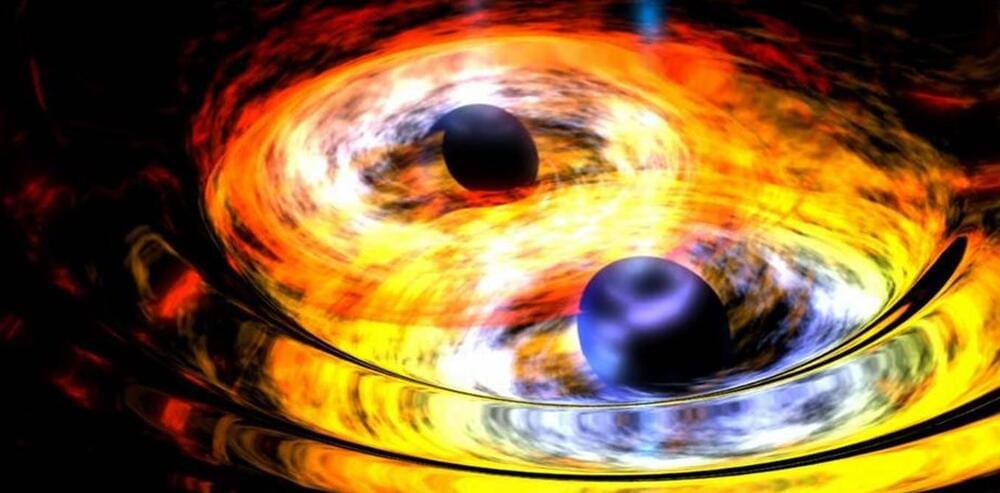The LUX-ZEPLIN detector searched for elusive WIMP particles for 60 days on its first scientific run. Did it detect dark matter?
Category: cosmology – Page 285

Prospecting for interstellar oil
We have developed a new method to look for carbon compounds in space, akin to prospecting for oil on Earth. Our method is published in Monthly Notices of the Royal Astronomical Society.
Between the stars lie vast amounts of interstellar gas and dust, spread thinly throughout our galaxy. The dust can contain compounds of carbon. When it does we call it carbonaceous interstellar dust. This is an important reservoir for the organic material in space. The continual cycle of material between the stars and the gas in the interstellar medium in our galaxy leads to the delivery of organic molecules to newly forming planetary systems.
A special sub-class of organic molecules called prebiotic molecules are thought to play a major role in the formation of life on Earth. Such prebiotic molecules are likely preserved in carbonaceous interstellar dust that are gathered together in planetesimals, in an early stage of planetary formation. The chemical composition in such environments may determine the planet’s hospitality to the formation of life there. Therefore, it is important to understand the life cycle of carbonaceous interstellar dust to study this possibility further.
Wormholes: In Episode 4 we look at the concept of wormholes
How they derive from General Relativity, the various different types and theories, and some under-considered uses of wormholes. We’ll also discuss some myths and misunderstandings of the concept.
Support the Channel on Patreon:
https://www.patreon.com/IsaacArthur.
Listen or Download the audio of this episode from Soundcloud:
https://soundcloud.com/isaac-arthur-148927746/ftl04-wormholes.
Cover Art by Jakub Grygier:
https://www.artstation.com/artist/jakub_grygier.
Matt Visser’s 1989 paper “Traversable wormholes: Some simple examples”:
https://arxiv.org/abs/0809.
Colonizing Black Holes
Visit our sponsor, Brilliant: https://brilliant.org/IsaacArthur/
Black Holes are amongst the most destructive things in the Universe, but it may be that properly utilized, they might be the best places in the galaxy to live around in the future, and possibly right here in our own solar system too.
Check out the Paperclip Maximizer: https://watchnebula.com/isaacarthur.
Visit our Website: http://www.isaacarthur.net.
Support us on Patreon: https://www.patreon.com/IsaacArthur.
SFIA Merchandise available: https://www.signil.com/sfia/
Social Media:
Facebook Group: https://www.facebook.com/groups/1583992725237264/
Reddit: https://www.reddit.com/r/IsaacArthur/
Twitter: https://twitter.com/Isaac_A_Arthur on Twitter and RT our future content.
SFIA Discord Server: https://discord.gg/53GAShE
Listen or Download the audio of this episode from Soundcloud: Episode’s Audio-only version: https://soundcloud.com/isaac-arthur-148927746/colonizing-black-holes.
Episode’s Narration-only version: https://soundcloud.com/isaac-arthur-148927746/colonizing-bla…ation-only.
Credits:
Outward Bound: Colonizng Black Holes.
Episode 187, Season 5 E21
Written by:
Good news, universe! Scientists are one step closer to finally understanding dark matter
Dark matter is made up of axions, elementary particles that are full of suspense.
About 85 percent of our universe is believed to be composed of dark matter, a hypothetical material that does not interact with light. So it neither reflects nor emits nor absorbs any light rays, and therefore, we can not see this unusual form of the matter directly. However, to understand and explain the nature of dark matter, scientists have created various models.
Surprisingly, a new study has ruled out one such popular explanation of the dark matter, called the axion-like particle (ALP) cogenesis model. The exclusion of ALP means that scientists will now have to consider fewer models while conducting dark matter research. This would increase both the speed and accuracy of their research works and bring us one step closer to understanding the most strange phenomenon of the universe. matter is made up of axons. Recently, scientists from the University of Australia decided to exclude a popular model (ALP cogenesis model) that is used to explain the nature of dark matter.

Large Hadron Collider Successfully Restarted at Record Energy: Revving Up the Search for Dark Matter
The Large Hadron Collider detectors started recording high-energy collisions at the unprecedented energy of 13.6 TeV.
The Large Hadron Collider is once again delivering proton collisions to experiments, this time at an unprecedented energy of 13.6 TeV, marking the start of the accelerator’s third run of data taking for physics.
A burst of applause erupted in the CERN.


The Milky Way may have two supermassive black holes
Do supermassive black holes have friends? The nature of galaxy formation suggests that the answer is yes, and in fact, pairs of supermassive black holes should be common in the universe.
I am an astrophysicist and am interested in a wide range of theoretical problems in astrophysics, from the formation of the very first galaxies to the gravitational interactions of black holes, stars and even planets. Black holes are intriguing systems, and supermassive black holes and the dense stellar environments that surround them represent one of the most extreme places in our universe.
The supermassive black hole that lurks at the center of our galaxy, called Sgr A*, has a mass of about 4 million times that of our Sun. A black hole is a place in space where gravity is so strong that neither particles or light can escape from it. Surrounding Sgr A* is a dense cluster of stars. Precise measurements of the orbits of these stars allowed astronomers to confirm the existence of this supermassive black hole and to measure its mass. For more than 20 years, scientists have been monitoring the orbits of these stars around the supermassive black hole. Based on what we’ve seen, my colleagues and I show that if there is a friend there, it might be a second black hole nearby that is at least 100,000 times the mass of the Sun.
Unusual Fossil Galaxy Discovered on Outskirts of Andromeda — Could Reveal History of the Universe
A unique ultra-faint dwarf galaxy has been discovered on the outer fringes of the Andromeda Galaxy thanks to the discerning eyes of an amateur astronomer examining archival data processed by NSF’s NOIRLab’s Community Science and Data Center. The dwarf galaxy — Pegasus V — was revealed to contain very few heavier elements and is likely to be a fossil of the first galaxies in follow-up observations by professional astronomers using the International Gemini Observatory, a Program of NSF’s NOIRLab.
An unusual ultra-faint dwarf galaxy has been discovered on the edge of the Andromeda Galaxy with the help of several facilities of NSF’s NOIRLab. Called Pegasus V, the galaxy was first detected as part of a systematic search for Andromeda dwarfs coordinated by David Martinez-Delgado from the Instituto de Astrofísica de Andalucía, Spain, when amateur astronomer Giuseppe Donatiello discovered a curious ‘smudge’ in data in a DESI
The Dark Energy Spectroscopic Instrument (DESI) is a new instrument for conducting a spectrographic survey of distant galaxies that has been retrofitted onto the Mayall Telescope on top of Kitt Peak in the Sonoran Desert 55 miles distant from Tucson, Arizona. Its main components are a focal plane containing 5,000 fiber-positioning robots and a bank of spectrographs which are fed by the fibers. It enables an experiment to probe the expansion history of the Universe and the mysterious physics of dark energy.

Ask Astro: What are the differences between supernovae, kilonovae, and hypernovae?
In Latin, nova means “new.” In astronomy, that refers to a temporary bright “star” in the night sky. But the causes of these brief but brilliant stars are varied.
Classical novae occur in a binary star system with a white dwarf and a star close enough together that the white dwarf pulls, or accretes, material from its companion. The material — mostly hydrogen — sits on the surface of the white dwarf until enough has been gathered to kick-start a nuclear fusion reaction, the same process that powers the Sun. As the hydrogen is converted into heavier elements, the temperature increases, which in turn increases the rate of hydrogen burning. At this point, the white dwarf experiences a runaway thermonuclear reaction, ejecting the unburnt hydrogen, which releases 10,000 to 100,000 times the energy our Sun emits in a year. Because the white dwarf remains intact after blowing away this excess, a stellar system can experience multiple classical novae.
Kilonovae occur when two compact objects, like binary neutron stars or a neutron star and a black hole, collide. These mergers, as their name suggest, are about 1,000 times brighter than a classical nova, but not as bright as a supernova, which is 10 to 100 times brighter than a kilonova.